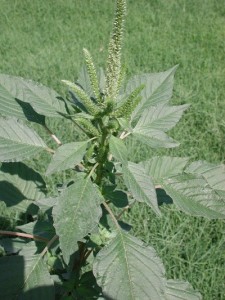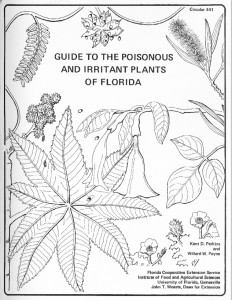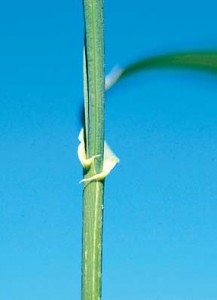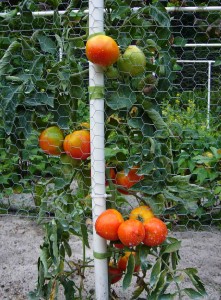 If you haven’t heard of Palmer Amaranth you probably will because it’s the Bull in the Botanical China Shop. The amaranth has become resistant to glyphosate which is an agricultural weed killer. Resistant Palmer Amaranth has taken over crops fields in Georgia and has been found some 20 other states. It’s coming to a farm near you, as are other resistant wild edibles. A lot of controversy centers on whether Palmer Amaranth that is resistant to glyphosate is edible. Media reports have not been helpful and the Internet, which has little quality control, has not clarified the issues. Here at ETWs we have an interest in edibility so we’ve taken an in-depth look at the controversy. In the time to come the question of edibility of resistant species will come to include your local amaranth and other wild edibles. Is glyphosate-resistant Palmer Amaranth edible? Click here.
If you haven’t heard of Palmer Amaranth you probably will because it’s the Bull in the Botanical China Shop. The amaranth has become resistant to glyphosate which is an agricultural weed killer. Resistant Palmer Amaranth has taken over crops fields in Georgia and has been found some 20 other states. It’s coming to a farm near you, as are other resistant wild edibles. A lot of controversy centers on whether Palmer Amaranth that is resistant to glyphosate is edible. Media reports have not been helpful and the Internet, which has little quality control, has not clarified the issues. Here at ETWs we have an interest in edibility so we’ve taken an in-depth look at the controversy. In the time to come the question of edibility of resistant species will come to include your local amaranth and other wild edibles. Is glyphosate-resistant Palmer Amaranth edible? Click here.
 ♣ What do you carry into the field to help you identify and collect wild edibles? After a lifetime of traipsing in the hinterlands I have an assortment of items I take with me. Admittedly I don’t usually don’t carry field guides but I do carry items to help identify various plants there or later. One item is what we used to call a small hand loop, a magnifying glass. They can be bought for a few dollars in stamp and coin shops. I like the sliding square ones over the fancier metal round loops and here is why. The round metal loops usually don’t let in enough light to see what you are looking at whereas a lense that is 1.5 inches across makes things far easier. Why would I want a loop? Hmmm… consider the difference between Blueberries and Huckleberry. Blueberries can be black and Huckleberries, usually, black can be blue. But on the back of every huckleberry leave are brilliant gold gands that you can see with a hand loop. Also huckleberries have exactly 10 seeds. The number of blueberry seeds vary. To read more about my Tools Of The Trail click here. To read about Blueberries click here, huckleberries click here.
♣ What do you carry into the field to help you identify and collect wild edibles? After a lifetime of traipsing in the hinterlands I have an assortment of items I take with me. Admittedly I don’t usually don’t carry field guides but I do carry items to help identify various plants there or later. One item is what we used to call a small hand loop, a magnifying glass. They can be bought for a few dollars in stamp and coin shops. I like the sliding square ones over the fancier metal round loops and here is why. The round metal loops usually don’t let in enough light to see what you are looking at whereas a lense that is 1.5 inches across makes things far easier. Why would I want a loop? Hmmm… consider the difference between Blueberries and Huckleberry. Blueberries can be black and Huckleberries, usually, black can be blue. But on the back of every huckleberry leave are brilliant gold gands that you can see with a hand loop. Also huckleberries have exactly 10 seeds. The number of blueberry seeds vary. To read more about my Tools Of The Trail click here. To read about Blueberries click here, huckleberries click here.
♣ Articles uploaded this week: Quack Grass, Spinach Vine, Edible Flowers Part Seven
 ♣ Over 30 years ago the state of Florida put together a handbook on poisonous and irritating plants. Green Deane’s been around long enough to have a hard copy of that publication. I have copied the pages and created a post of them. The original book was typewritten so it is a little difficult to read but readable. Unlike the original publication, I put the index in the front, or in this case, at the top. It is not indexed by page or alphabetical but by number. There’s also five pages not indexed, listed at the end. To browse the handbook, click here.
♣ Over 30 years ago the state of Florida put together a handbook on poisonous and irritating plants. Green Deane’s been around long enough to have a hard copy of that publication. I have copied the pages and created a post of them. The original book was typewritten so it is a little difficult to read but readable. Unlike the original publication, I put the index in the front, or in this case, at the top. It is not indexed by page or alphabetical but by number. There’s also five pages not indexed, listed at the end. To browse the handbook, click here.
 ♣ Botany Builder #6: Auricle, a small ear-like projection from the base of a leaf or petal. Auricles are also seen at the base of the leaf blade in grasses. In an earlier Botany Builder we covered leaves and how they attach to the main stem usually with a smaller stems (petiole) or directly, sessile. Sessile leaves usually attach directly to the main stem. Often parts of that leaf will reach around or past the stem creating auricles, which become handly elements of identification. One grass that is rather easy to identify because of auricle is Quack Grass, to right. “Auricle” is from auricula which is Dead Latin for “little ear.”
♣ Botany Builder #6: Auricle, a small ear-like projection from the base of a leaf or petal. Auricles are also seen at the base of the leaf blade in grasses. In an earlier Botany Builder we covered leaves and how they attach to the main stem usually with a smaller stems (petiole) or directly, sessile. Sessile leaves usually attach directly to the main stem. Often parts of that leaf will reach around or past the stem creating auricles, which become handly elements of identification. One grass that is rather easy to identify because of auricle is Quack Grass, to right. “Auricle” is from auricula which is Dead Latin for “little ear.”
♣ Did you know that tomatoes are botanically a fruit? That fact was the basis for a case before the US Supreme Court in 1893, Nix v. Hidden. Ten years earlier in 1883 the federal government has passed a tariff act that included fresh vegetables. In 1886 an importer brought into the country through New York City a load of tomatoes from the West Indies. The government collected a tax and the importer appealed arguing the tariff act did not include fruit and since tomatoes are fruits they should not be taxed. It took five years for the case to reach the Supreme Court which ruled tomatoes were used like vegetables so they can be taxed like vegetables. There was precedence, Robertson v. Salomon, 130 U.S. 412 (1889). In that case the argument was made that botanically beans are seeds and thus were exempt from the 1883 tariff act which did not tax seeds. In that earlier case the court found beans were used like vegetables thus pay the tax man. In 2005 the state of New Jersey cited Nix v. Hidden when voting to make the tomato the official vegetable of New Jersey.
So, botanically what’s the difference between a fruit and a vegetable? Technically if it has seeds it is a fruit. Cucumbers, squash, green beans and walnuts are all fruits. If you want to be picky we really don’t eat vegetables. We eat leaves (lettuce) stems (celery) roots (carrots,) tubers (potatoes) corms (onions) and flowers (broccoli.) The word “vegetable” is really rather informal and not too informative. To read about a wild vegetable that is closely related to the tomato click here.
♣ Yesterday (Dec. 4th) I held a class in West Palm Beach. I always enjoy heading down to the south end of the state because it has such a different set of flora, no freezes and all kinds of tropicals. It’s an excuse to ride the motorcycle 400 miles. You also see iguanas running around. I hear they are good with curry. And of course the other reason is its warmer there this time of year. I’ll be heading down to Port Charlotte, on the west side of the peninsula, Dec. 18th.
Classes schedule this week, people have already signed up. To learn more click here.
Saturday, December 10th, Mead Garden: 1500 S. Denning Dr., Winter Park, FL 32789. 9 a.m.
Sunday, December 11th, Florida State College, south campus, 11901 Beach Blvd., Jacksonville, 32246. 9 a.m.
To donate to the Green Deane Newsletter click here.



If you go to my home page and type pennywort in the search window the dollarweed article is the fifth one listed. Or, you can click on archive and scroll down to pennywort.